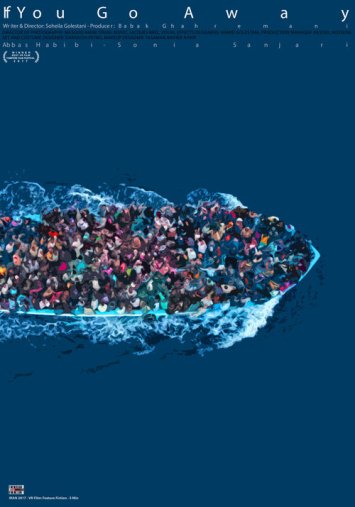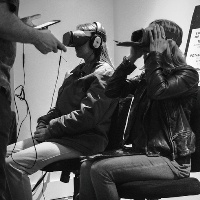— reviewed by Matt Willis, Orcas Issues reporter —
This year the Orcas Island Film Festival (OIFF) plunged headlong into the future of storytelling by augmenting its usual lineup of traditional “film” narratives with what it called a “360/VR Lab.”
Many of the Virtual Reality (VR) stories presented, however, fell short of their intended mark because their directors failed to understand the fundamental nature of virtual reality as a narrative medium. One, however, clearly excelled, becoming the single standout story and setting the minimum standard to which others should aspire next season.
 The event was hosted by Rock Island Communications, in partnership with Seattle’s WonderTek Labs. They both did a stand-up job in their work with the OIFF. My VR experience was completely glitch free – no small accomplishment when you’re dependent on the bleeding edge of technology.
The event was hosted by Rock Island Communications, in partnership with Seattle’s WonderTek Labs. They both did a stand-up job in their work with the OIFF. My VR experience was completely glitch free – no small accomplishment when you’re dependent on the bleeding edge of technology.
Congratulations also go to the OIFF producers and directors for taking on this new world of immersive story-telling, and leading the charge to help mature an emerging medium.There are two main differences between the narrative mediums of traditional and virtual reality (there’s actually a third important difference, interactivity, but it isn’t relevant to any of the stories presented at the VR Lab). I’ll briefly discuss each below, and then describe how the standout at this year’s VR Lab used them to build a truly unique and powerful experience.
As an audience member in a traditional film narrative you sit in front of a large screen and the action takes place in front as you watch alongside other members of the audience. It’s obvious that you’re in a theater. You don’t feel the desire to move around the set and explore it. The action is always right in front of you, or you know it soon will be.
This isn’t the case in VR stories. VR can be visually immersive and game-like, encouraging you to move around freely. You are on set, along with the props and actors, so why not explore? Not all VR narratives allow freedom of movement, however. It’s nearly impossible to tell a story if audience members aren’t where the action takes place. So, many pioneers in the VR story-telling space forego freedom of movement. But this presents another challenge.
When immersed in VR, you naturally want the freedom to explore. Without that freedom of movement It’s like sitting in an invisible roller coaster cart, with a big screen glued in front of your field of view. Unconsciously, the lack of freedom is annoying and confining. Unfortunately, this was the case for all but one of the twelve stories at the VR Lab (though “After Solitary” modestly uses this unintended effect to its advantage, given that the story takes place in a prison’s solitary confinement cell).
Soheila Golestani, the director of “If You Go Away,” understood this quandary and devised a way to allow the audience to be sated in their confinement. The experience begins with you sitting at the aft of a small boat. The motor is behind and to your right, which you notice when you turn your head in that direction. As you look around, the water surrounding the boat is gray and churning. It looks cold, uninviting. Two men with you navigate the boat towards a nearby shoreline where a dispersed crowd appears to eagerly await your arrival. They stand in waist-deep water. Audio of Jacques Brel singing his famously remorseful song, “Ne Me Quitte Pas” (Don’t Leave Me) plays in the background. The atmosphere is full of anxiety as you wait nervously for something unknown but inevitable to happen.
These elements compel you to stay seated in the boat and unconsciously go along with the narrative. It never enters your mind that you’d like to get into the cold water and explore. The boat is safe, and where you want to be; and you’re curious why these people have gathered for your arrival. Soheila has expertly overcome one of the biggest challenges in VR story-telling by creating subtle tensions that allow her to remain, naturally, in control of the narrative.
Related to the issues presented by freedom of movement versus confinement is that of directing the audience’s attention versus allowing them to peer wherever they wish. In a VR world, though you may be seated, you can still turn you head and look around. You can look behind, above and below. You may be in the desired location on the set, but, what happens if you miss important events because you’re looking in the wrong direction? What if the director actually wants you to turn and look behind you at a certain point in the story? These challenges require the director to rely completely on their mastery in subtly designing the set, visual and audio cues, and event flow so that everything feels completely natural and you unconsciously suspend any desires to exert your desires to move around the set.
Most of the VR stories presented at the lab failed to do this. Some cheated by visually mirroring the world so that if you turned away too far the initial 180° of your field of view repeated. This completely destroyed any feeling of immersion.
Others, like “The Giant,” move you along uncontrollably in the experience via the invisible roller coaster mentioned previously. The object of each scene is always within your field of view. This too severely undermines any feeling of true immersion. Unless your movement in the set is somehow subtly explained by the story it doesn’t feel natural. Unconsciously, your brain wonders why and how you’re moving.
On the other end of this extreme was “The Town that Blew Away,” a VR story that gives you total freedom to look around while moving you from location to location. While doing so, the narrator recited text which seemed so generalized and abstracted from the visual experience that it failed to enhance the story in any way. It was like being given a broad history lesson of Seattle while you sit awkwardly looking around on one of those Duck Tours (not that the Duck Tour drivers do that – they’re witty banter is tied directly to your visual experience, which makes it relevant and entertaining). The intent might have been to enhance your understanding of some broader concept. But, it felt contrived, too cerebral and forced.
Soheila masterfully navigates these challenges in “If You Go Away.” As you near the shore while sitting in the boat the crowd naturally holds your attention. The plot unfolds slowly. Turning your head to briefly look around only deepens the sense of immersion by enhancing the atmospheric effect of your surroundings.
As the boat enters the waters amongst the crowd it’s quickly turned about, facing out to sea in preparation for a hasty departure. The people in the water clamor to board the vessel. There is no orderly line. The desperate look on their faces indicate that this is about survival.
A small boy now on board sits in front of you. He looks around, anxious to locate someone – perhaps his parents. As it dawns on you that there’s not enough room for everyone you’re swept away in the emotion that those around you feel. Empathizing, you frantically look around to try and spot the young boy’s parents and to see who else will be left behind.
Next to the boy, a woman clenches her husband’s arm as he stands in the turbulent water next to the overly full boat. Her expression pleads with him. If they become separated she may never see him again. She’s afraid to do this alone. At the same time, Jacques Brel’s voice pleads repeatedly, “Don’t leave me, don’t leave me…” though it’s obvious that being left is inevitable.
In a panic, the woman stands and leaps overboard. You turn to the left and peer over the side, following her as she swims back towards her husband standing now in the far distance. Will she make it wearing all of that heavy clothing? At the same time you realize that so many others have been left behind, alone to face an unknown and terrible fate.
In its brief five minutes “If You Go Away” envelopes us completely in an experience that is authentically enhanced by the differences between the mediums of traditional and VR narrative.– no gimmicks or cheats. It’s a brilliant glimmer of what’s in store for us as this new medium matures.
VR can offer greater freedom to the director and the audience. However, the pioneers of this medium that fully understand this freedom and that can subtly use it (or not) to create a natural-feeling experience will become the masters of this more potent medium for story-telling.
We should all look forward eagerly – and maybe even anxiously – for OIFF’s fore into this potentially more potent story-telling medium next year.
**If you are reading theOrcasonian for free, thank your fellow islanders. If you would like to support theOrcasonian CLICK HERE to set your modestly-priced, voluntary subscription. Otherwise, no worries; we’re happy to share with you.**








